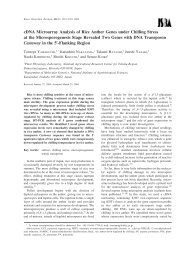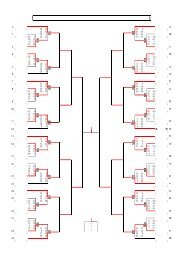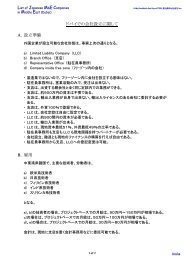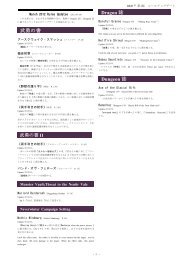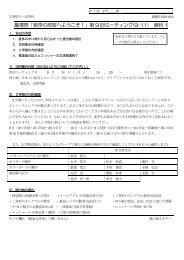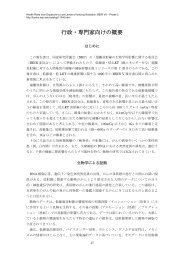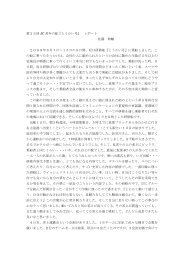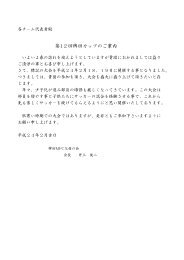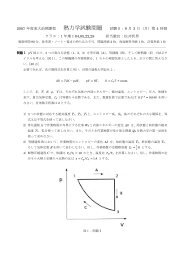You also want an ePaper? Increase the reach of your titles
YUMPU automatically turns print PDFs into web optimized ePapers that Google loves.
www.cambridge.orgInformation on this title: www.cambridge.org/9780521868945© Peter Yule and Derek Woolner 2008This publication is in copyright. Subject to statutory exceptionand to the provisions of relevant collective licensing agreements,no reproduction of any part may take place withoutthe written permission of Cambridge University Press.First published 2008Printed in Australia by LigareA catalogue record for this publication is available from the British LibraryNational Library of Australia Cataloguing in Publication dataYule, Peter<strong>The</strong> <strong>Collins</strong> <strong>Class</strong> <strong>Submarine</strong> story: steel, spies and spin/authors, Peter Yule, Derek Woolner.Cambridge; Port Melbourne, Vic.: Cambridge University Press, 2008.978-0-521-86894-5 (hbk.)Includes index.Australia. Royal Australian Navy – Procurement.Australia. Dept. of Defence – Procurement.<strong>Collins</strong> <strong>Class</strong> (<strong>Submarine</strong>)<strong>Submarine</strong>s (Ships) – Australia.Woolner, Derek, 1946–359.93830994ISBN-13 978-0-521-86894-5Cambridge University Press has no responsibility forthe persistence or accuracy of URLs for external orthird-party internet websites referred to in this publicationand does not guarantee that any content on suchwebsites is, or will remain, accurate or appropriate.Contents
21. ‘A patch on this and chewing gum on that’: the combat system 1993–97 2444 RESOLUTION 25522. ‘Hardly a day went by without the project getting a hammering in the press’: the project incrisis 1997–9825723. ‘Bayoneting the wounded’: the McIntosh-Prescott report 27424. ‘That villain Briggs’ and the submarine ‘get-well’ program 28725. ‘Inside the American tent’: the saga of the replacement combat system 29926. ‘We’ll do it and get rid of the buggers’: Kockums, ASC and Electric Boat 31027. ‘We would find that challenging’: comparison and retrospect 319Notes 330Index 349LIST OF KEY PEOPLENote: date/s of interviews with the authors are indicated in square brackets following the names listed below.Carl Johan Åberg, Swedish Minister for Foreign Trade mid-1980s [10 November 2006]Marcos Alfonso (Commander RAN), submariner; engineer HMAS <strong>Collins</strong> [2 August 2006]Eoin Asker (Commodore RAN), submariner; fourth Project Director 1997–2000 [14 June 2006]Paul Armarego, lawyer for SMCT [16 May 2006]Jack Atkinson, General Manager Design and Engineering, ASC [31 March 2006]Tony Ayers, Secretary, Department of Defence 1988–98John Bannon, Premier of South Australia 1982–92 [11 July 2006]Paul Barratt, Secretary, Department of Defence 1998–99 [10 April 2006]John Batten (Commander RAN), project office; developed Australian industry involvement policy and contractmanagement system for project [2 March 2006]
Kim Beazley, Minister for Defence 1984–90 [28 February 2006]Allan Behm, Defence policy analyst [20 April 2006]Bo Benell, General Counsel, Kockums [21 November 2006]Fred Bennett, Chief of Capital Procurement, Department of Defence 1984–88 [8 March 2007]Jim Berger, executive, CBI and ASCDoug Bews, Production Manager, ASCKurt Blixt (Major General, Swedish army), Assistant Under-Secretary for Procurement, Swedish Ministry forDefence [14 November 2006]Richard Brabin-Smith, Chief Defence Scientist [16 February 2006]Peter Briggs (Rear Admiral RAN), submariner; submarine policy maker; head of SMCT [7 March 2006; 18 July2006]Pår Bunke, executive, Kockums; Deputy Managing Director, ASC 1990–93 [18 November 2006]John Butler (Rear Admiral USN), led American assistance to the project [1 February 2006]John Button, Minister for Industry 1983–93 [25 October 2005]Doug Callow, Senior Engineer, ASC [31 March 2006]Rick Canham (Captain RAN), submariner; led project team in SwedenRoine Carlsson, Swedish Minister for Defence mid-1980s [14 November 2006]Laurie Carmichael, Australian Metal Workers Union, ACTUTony Carter (Captain RAN), Project Support ManagerDon Chalmers (Vice Admiral RAN), Chief of Navy 1997–99 [17 May 2006]Graeme Ching, executive, CBI and ASCGöran Christensson, engineer, Kockums and ASCBob Clark, Operational Software Manager, SWSC, project and DMO [6 October 2006]Peter Clarke (Rear Admiral RAN), ex-RN submariner; Project Manager [18 May 2006]Peter Climas, technical officer, DSTOJanice Cocking, scientist, DSTO
Colin Cooper, ex-RN submariner; engineer; Combat System Project Manager [18 April 2007]Orm Cooper (Captain RAN), director of major procurement projects in the early 1980s [30 March 2006]Tim Cox (Commodore RAN), Director General of Maritime Development [15 November 2006]Harry Dalrymple (Commodore RAN), Director General of Naval Design 1980–89 [10 March 2006; 3 April 2006]Geoff Davis, Managing Director, Wormald Limited; first Chairman ASC [14 August 2006]Phil Davis (Rear Admiral USN), led USN assistance to <strong>Collins</strong> project [28 February 2007]Peter Dechaineux (Commodore RAN), engineer; prepared history of project 1999 [18 May 2006]Paul Dibb, Defence policy strategist [30 May 2006]John Dickens, scientist, DSTORon Dicker, Dutch submariner; managed Signaal bid; Combat System Manager, ASC [24 July 2006; 31 August2006]John Dikkenberg (Captain RAN), submariner; squadron commander, test and trials [15 August 2006]Brian Dixon, scientist, DSTOBill Dovers (Rear Admiral RAN), logistics and personnel issues [30 May 2006]Jim Duncan (Commander RAN), managed South Australian bid [27 April 2006]Mick Dunne (Commodore RAN), submariner; critic of <strong>Collins</strong> project [27 April 2006]Ulf Edman, Swedish submariner; Commodore, Swedish submarine squadron [14 November 2006]Martin Edwards, engineer, ASC [10 July 2006]David Elliston, Commercial Manager at project office [1 March 2006]Bruce Fairlie, scientist, DSTORod Farrow, Combat System Project Manager, CSA [19 February 2007]Rod Fayle (Commander RAN), submariner; Operational Requirements Manager [26 April 2006]David Ferguson, lawyer, Minter Ellison; acted for Kockums and other Swedish companies [22 November 2005]Mark Gairey, naval architect; sixth Project Director [22 August 2006]Mike Gallagher (Commander RAN), first CO of Farncomb; worked for STN and Raytheon [8 August 2006]
Paul Gashler (Captain RAN), Project Support Manager 1988–90Mark Gobell, engineer, ASC [10 July 2006]Geoff Goodwin, scientist, DSTO [18 June 2007]Paul Greenfield (Commodore RAN), submariner; fifth Project Director [1 March 2006]Ken Greig (Captain RAN), submariner; Project Manager and Senior Engineer [1 June 2006]Steven Gumley, CEO, ASC and DMO [8 June 2006]Ove Gustafsson, CEO, Pacific Marine Batteries [31 March 2006]Kenneth Håkansson, welding engineer, KockumsJohn Halfpenny, Secretary, Amalgamated Metal Workers Union 1972–87Gösta Hardebring, General Manager, Saab Naval Systems [15 November 2006]Keith Harper, Project Design Manager 1983–85Peter Hatcher (Commodore RAN), submariner; Combat System Development Manager; Project Manager [23August 2006]Allan Hawke, Secretary, Department of Defence, 1999–2002 [4 August 2006]Bill Hicklen, executive, CBIPeter Hider, Deputy Project Director; negotiated contracts [22 August 2006]Ian Hill (Commander RAN), Combat System Project ManagerRobert Hill, Minister for Defence 2001–06Tomy Hjorth, Managing Director, Kockums; Chairman of ASC [13 November 2006]Paddy Hodgman (Captain RAN), Chief Staff Officer to Chief of Navy 1997–99 [2 March 2006]Olle Holmdahl, headed Kockums design team; Deputy Managing Director, ASC [29 August 2006]Robert Holtsbaum, lawyer, Minter Ellison; acted for Kockums [17 November 2005]Peter Horobin (Lieutenant Commander RAN), submariner; worked as consultant on many aspects of project [7August 2006]Mike Houghton (Captain RAN), submariner; engineer; liaison officer with Kockums [1 February 2006]Tony Houseman, Contracts Manager, CSA [19 June 2006]
Brian Howe, Minister for Defence Support 1983–84 [25 November 2005]Mike Hudson (Vice Admiral RAN), Chief of the Navy 1985–91Oscar Hughes (Rear Admiral RAN), engineer; second Project Director 1985–93 [16 January 2005; 20 February2007]Peter Hugonnet (Captain RAN), submariner; engineer; responsible for submarine safety system [8 June 2006]Peter Jennings, Chief of Staff to Minister for Defence 1996–97 [19 July 2006]John Jeremy, Managing Director, Cockatoo Island Dockyard 1981–91 [23 June 2005; 15 August 2006]Andrew Johnson, combat system software engineer, SWSC and CSA [22 March 2006; 27 March 2006]Doug Jones, lawyer, Clayton Utz [8 February 2007]Garry Jones, Deputy Secretary Acquisition and Logistics, 1994–99Wal Jurkiewicz, lawyer for SMCT [16 May 2006]Bruce Kean, CEO, Boral; Director, ASC [12 December 2005]Al Konetzni (Vice Admiral USN), Commander of <strong>Submarine</strong> Force USNJohn Kroll, manager, Bisalloy Industrial SteelsRobert Lemonius, senior engineer, ASC [7 August 2006]John Lewis, DSTO scientistHans Peder Loid, naval architect, SSPA Sweden [23 November 2006]Ian MacDougall (Vice Admiral RAN), first submariner to be Chief of Navy [16 June 2006]Malcolm McIntosh, Deputy Secretary Acquisition, co-author McIntosh-Prescott ReportIan McLachlan, Minister for Defence 1996–98Ron McLaren, Project Financial Manager [18 December 2006]Roger Mansell, executive, Wormald and ASCRobert Mansfield, corporate raiderAndrew Millar (Commander RAN), staff officer to Project Director [12 August 2005; 17 January 2006]Chris Miller, software engineer, CSA [14 August 2006]
Mick Millington, combat system engineer with SWSC and CSA [8 July 2006]Ross Milton, executive, CBI and ASC [10 July 2006]Dennis Mole (Commodore RAN), submariner; head of submarine squadron [15 August 2006]John Moore, Minister for Defence 1998–2000 [28 April 2006]Maurice de Morton, scientist, DSTOJim Muth, executive, CBI and ASCRick Neilson, combat system engineer with SWSC, Rockwell and Boeing [5 July 2006]Ian Noble (Captain RAN), Operational Technical Requirements Manager [22 August 2006]Chris Norwood, scientist, DSTO [12 June 2007]Hans Ohff, engineer; Managing Director of Eglo Engineering and ASC [6 February 2006; 9 February 2007]Gunnar Öhlund, Technical Director, Kockums [17 November 2006]David Oldfield, scientist, DSTO [5 May 2006]John O’Neill, executive, Kockums and ASCBill Owen (Captain RAN), ex-RN submariner; Director of <strong>Submarine</strong> Policy 1971–76; head of submarinesquadron 1976–79; critic of <strong>Collins</strong> project [16 May 2006]Frank Owen (Commander RAN), submariner; Operational Requirements Manager [17 May 2006]Chris Oxenbould (Rear Admiral RAN), Deputy Chief of Navy 1997–99 [15 June 2006]John Pascall, combat system engineer, SWSC and Rockwell [14 June 2006]Stephanie Paul, Phillips Group; ran public relations for SMCT [5 July 2006]Paul-E Pålsson, President of Kockums 1987–91 [18 November 2006]Olle Person, diesel engine consultant, Kockums and Hedemora [13 November 2006]Forbes Peters (Commander RAN), submariner; engineer; navy supervisor of Waller refit [31 March 2006]Bob Phillips, scientist, DSTOJohn Prescott, Managing Director of BHP; co-author of McIntosh-Prescott Report; Chairman of ASC [12 April2006]Robert Ray, Minister for Defence 1990–96
Peter Reith, Minister for Defence 2000–01Dick Riddell (Rear Admiral USN), submariner; chief US naval research and development adviser to allied naviesSimon Ridgway, engineer, ASC [31 March 2006]Chris Ritchie (Vice Admiral RAN), Chief of Navy 2002–05John Ritter, scientist, DSTO [21 March 2006]Juergen Ritterhoff (Professor), head of IKL design team [22 November 2006]Terry Roach (Commodore RAN), submariner; leading submarine policy maker [17 May 2006]Trevor Robertson (Commander RAN), first CO of HMAS <strong>Collins</strong> [8 February 2007]Mick Roche, head of DMO 1999–2004Geoff Rose (Commodore RAN), submariner; third Project Director 1993–97 [20 August 2006]Bill Rourke (Rear Admiral RAN), Chief of Naval Materiel; early advocate of building in Australia [2 March 2006]Jeff Rubython, executive, Wormald and ASCHans Saeger, headed HDW bid [22 November 2006]Alan Saunders, ASC engineer, ex-Cockatoo IslandKevin Scarce (Rear Admiral RAN), DMO division head for naval project & support [30 March 2006]Bill Schofield, DSTO scientist, head of aeronautical and maritime research laboratoriesDavid Shackleton (Vice Admiral RAN), Chief of Navy 1999–2002 [17 May 2006]Rick Shalders (Commodore RAN), head of submarine squadron [8 August 2006]David Simcoe, DMO naval engineer [19 June 2007]Peter Sinclair (Captain RAN), CO of HMAS <strong>Collins</strong> during sea trials [16 June 2006]Tony Smith (Commander RAN), submariner; worked for ASC, Boeing and Raytheon [1 February 2006]Keith Snell, consultant involved at many times during project; principal SMA [27 July 2006]Roger Sprimont, Swedish submariner; head of Kockums’ bid; chairman, ASC 1987–89 [10 November 2006]Karl Bertil Stein, combat system and weapons engineer, Kockums [20 November 2006]Pelle Stenberg, Swedish submariner; executive, Kockums [16 November 2006]
Greg Stuart, project senior platform engineer [21 August 2006]Tore Svensson, design engineer, Kockums [17 November 2006]Ebbe Sylven, Swedish submariner; Swedish representative on Australia-Sweden government steeringcommittee [14 November 2006]John Taylor, welding engineer, ASCRod Taylor (Vice Admiral RAN), Chief of Naval Staff 1994–97Jock Thornton, ASC engineer; ex-RN submarinerTed Vanderhoek, software specialist with SWSC and submarine project [16 August 2006]Patrick Walters, national security correspondent for major metropolitan dailies [7 August 2006]Graham White (Captain RAN), first Project Director 1982–85 [5 August 2005; 6 August 2006]Hugh White, staff member to Defence Minister Kim Beazley; Deputy Secretary under Defence Minister JohnMoore [27 March 2006]John White, ran campaign to build in Australia and the unsuccessful HDW bid [20 March 2006]Don Williams, Managing Director, ASC 1988–93Jim Williams, head of research, BHP WollongongDavid Wyllie, DSTO scientist; chief of the Maritime Platforms Division in 1998 [5 May 2006]Sandy Woodward (Vice Admiral RN), Falklands War commander and Flag Officer <strong>Submarine</strong>sAlan Wrigley, Deputy Secretary, Department of Defence 1979–85; queried basis for submarine project; Director-General of ASIO 1985–88 [15 November 2006]Charles Yandell, production manager, ASC; ex-Cockatoo IslandJohn Young, Chairman of the Management Board, Atlas Elektronik [31 January 2006]LIST OF ACRONYMSACTUAustralian Council of Trade Unions
AMSASCCBICSACSCDAODMODSTOFMVHDWIKLMTURANRNSMASMCTSSPASWSCUSNAustralian Marine Systems Pty LtdAustralian <strong>Submarine</strong> Corporation Pty LtdChicago Bridge and Iron Inc.Computer Sciences of AustraliaComputer Sciences CorporationDefence Acquisition OrganisationDefence Materiel OrganisationDefence Science and Technology OrganisationFörsvarets Materielverk (Swedish Defence Materiel Administration)Howaltswerke Deutsche WerftIngenieur Kontor LübeckMotoren und Turbine Union Friedrichshafen GmbHRoyal Australian NavyRoyal NavyScientific Management Associates<strong>Submarine</strong> Capability TeamSSPA Maritime Consulting AB, Göteborg, Sweden<strong>Submarine</strong> Warfare Systems CentreUnited States Navy
INTRODUCTION<strong>The</strong> construction of the <strong>Collins</strong> class submarines was Australia’s largest, most expensive and most controversialmilitary purchase. <strong>The</strong> project had its origins in the late 1970s and the last submarine was delivered to the navyin 2003. During that period it was subjected to an unprecedented level of media scrutiny and criticism, becamehighly politicised and on several occasions faced the prospect of being abandoned.<strong>The</strong> general public perception of the submarine project is that it was a hugely expensive failure and that thesubmarines are noisy ‘dud subs’. <strong>The</strong>se views are not shared by those who were involved in designing, buildingor operating the submarines, or by the navy leadership and military analysts who see the project as anextraordinary industrial achievement and the submarines as potent weapons and among the best ofconventional submarines.<strong>The</strong>re is much that is unique about the <strong>Collins</strong> submarine project. It was the first class of major warshipdesigned specifically for Australian requirements – earlier classes were either bought from overseas or built toplans developed for other navies. Australian industry was more heavily involved than with any other modernmilitary purchase. It was the largest electronics systems integration project ever undertaken in Australia. <strong>The</strong>lengthy list has led advocates for the project to compare it with the Snowy Mountains Scheme for its ‘nationbuilding’significance.Nonetheless the project encountered serious difficulties, and for many different reasons these were notmanaged well. Even with the benefit of hindsight there is passionate disagreement on what went wrong, why itwent wrong and what should have been done. <strong>The</strong> only agreement among those involved in the project is thatthe final result is a fleet of excellent submarines.I was approached by Cambridge University Press to write this book, principally, I think, because I was the onlyperson they could find with no preconceptions of the submarine project. This was accompanied by an absenceof knowledge: I approached the project as a blank canvas, to be filled in by talking to as many of the protagonistsas possible along with surveying the massive quantity of documents generated during the project. My training isin history and I have attempted to carry out the research and analyse the evidence using the methods of ahistorian, although historians are not trained to deal with the strong emotions still felt about the project by manyof those involved.<strong>The</strong> aim of the book is simply to tell the story of the submarine project from its origins to about 2005. It is anextraordinary story with heroes and villains, intrigue, lies, spies and backstabbing. It is also a story of enormouscommitment and resolve to achieve what many thought was impossible. <strong>The</strong>re are lessons to be learnt from thestory, but they are for the readers to discover for themselves rather than the authors to prescribe, and differentpeople will see different lessons.<strong>The</strong> book deliberately avoids military jargon, ‘techno-speak’ and the universal euphemisms of military folk –
where weapons are called capabilities, assets, deterrents or systems, wars are conflicts or contingencies, and allmilitary activities, however aggressive in intent, come under the umbrella term ‘defence’. We have also avoidedthe military’s compulsive tendency to over-use capital letters and acronyms. <strong>The</strong> style of the book will be foreignfor those of service background or military enthusiasts, but is designed to make the story accessible to thoseconfounded by sentences like, ‘Raytheon has received a NAVAIR contract to further develop the JSOW AGM-154C1 (formerly JSOW Block III)’. Nor will the reader find such grandiloquent creatures as CINCPACFLT orCOMNAVSEASYSCOM. Both are (apparently) familiar figures to modern sailors, though Nelson must beshuddering in his grave.This book is not an analysis of what has been written about the project by journalists and academics and hasgenerally avoided using secondary sources. It is based on over 130 interviews with people involved in almostevery aspect of the project, and the documents, minutes, letters and diaries generated during the course of theproject. <strong>The</strong>se include the major evaluation studies of industry proposals, the Tender Evaluation Board Reportand the <strong>Submarine</strong> Evaluation Team Report, the minutes of the Force Structure Committee and the Chief ofNaval Staff Advisory Committee, the Project Quarterly Progress Reports, the Vickers Cockatoo Island DockyardReport on the construction of submarines in Australia and many other reports on the strategic and technicaljustifications for the project, and departmental files on specific issues.My task was made possible by the advice and guidance of my co-author, Derek Woolner, a military analystlong exposed to the ways of the Canberra bureaucracy. Derek carried out the documentary research inCanberra, wrote chapters 7–10, 15 and 20, contributed sections for several other chapters and helped in manyother ways. Admirals Peter Briggs and Boyd Robinson provided constant help and opened many doors, withoutin any way determining the conclusions reached. <strong>The</strong> staff of the submarine branch of the Defence MaterielOrganisation assisted in many ways and Colin Cooper deserves special thanks for maximising the authors’ useof the official record by his management of the security restrictions of classified documents.Many people have read portions of the draft and the authors thank them all for their helpful comments. We owespecial thanks for advice and encouragement to John Jeremy, Ron Dicker, Andy Millar, Jim Duncan, OlleHolmdahl, Oscar Hughes, Graham White, Greg Stuart and Hans Ohff. My visit to Sweden and Germany inNovember 2006 was made possible by Roger Sprimont, who arranged my interview program and helped greatlyin many ways. I received welcome help and hospitality from Pelle Stenberg, Ulf Edman, Pår Bunke, Hans PederLoid, Karl Bertil Stein, Kurt Blixt, Ebbe Sylven, Tomy Hjorth, Paul-E Pålsson, Olle Person, Gösta Hardebring,Roine Carlsson, Carl-Johan Åberg, Hans Saeger and Juergen Ritterhoff. <strong>The</strong> staff of Kockums went out of theirway to assist me and Gunnar Öhlund, Tore Svensson and Bo Benell provided me with much useful information.Similarly, ASC Pty Ltd (formerly the Australian <strong>Submarine</strong> Corporation) gave me every assistance and I amgrateful to Jayne Correll for organising interviews with ASC staff.Geoff Hook and Peter Nicholson have kindly given permission to reproduce their cartoons, which encapsulatesome of the more acrimonious debates and controversial aspects of the submarine saga. <strong>The</strong> followingindividuals and organisations have generously allowed us to use their photographs to illustrate significant stages
of the project and some of the key people involved: Peter Sinclair; the Royal Australian Navy; ASC Pty Ltd;Defence Science and Technology Organisation, Department of Defence; Force Element Group, Department ofDefence.Of the thousands of people involved in designing, building and operating the <strong>Collins</strong> class submarines, no twopeople fully agree on the ‘real story’ of the submarine project. Similarly few people will agree with all details inthe book, and many will be angered by some of the conclusions reached. While the authors accept responsibilityfor any errors of fact or interpretation, the lack of agreement on many issues remains one of the key features ofthe <strong>Collins</strong> submarine project, with the noise of the disputes still overshadowing the scale of the achievement.Peter YulePrinter friendly versionEmail a colleague© Cambridge University Press 2010. Privacy Policy | Terms of use | Contact us



